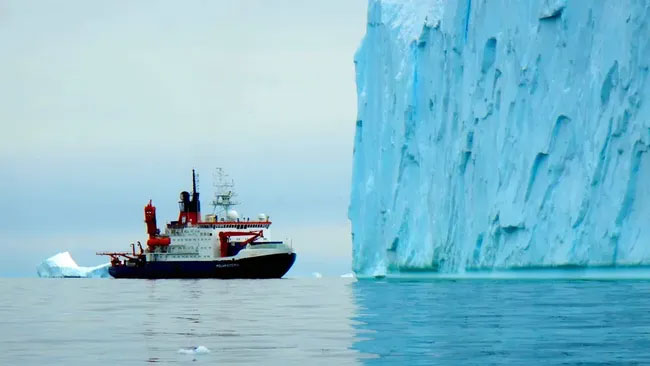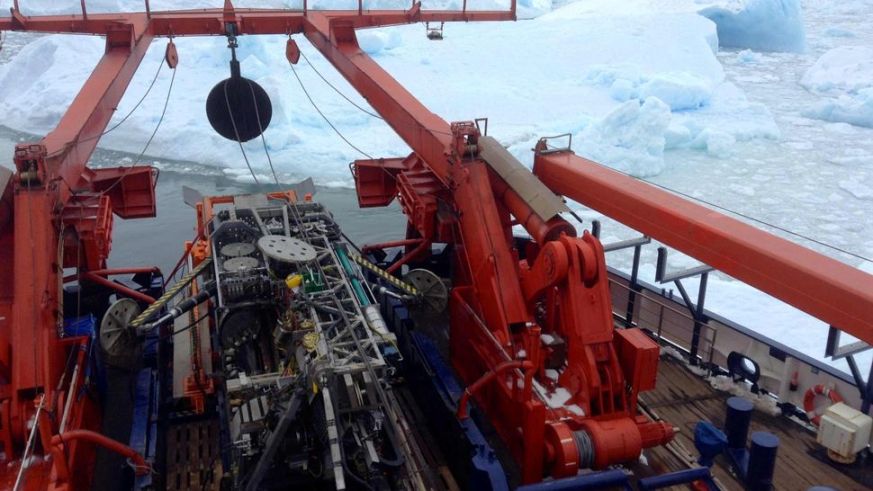According to research by experts from the University of Colorado Boulder, more and more fresh water has been entering the Arctic Ocean over the past two decades. If this trend continues, the freshening of the North Atlantic could disrupt ocean currents, the authors of the study fear. During the last ice age, the Earth experienced the highest increase in CO2: 14 parts per million in just 55 years. Deep beneath the ice of Antarctica, a giant river system has been discovered that existed 40 million years ago.
According to research by experts from the University of Colorado in Boulder, over the past two decades, more and more fresh water has been entering the waters of the Arctic Ocean. If this trend continues, then the desalination of the North Atlantic could disrupt ocean currents, the authors of the study fear. Similar situations have occurred before – in the 1970s and 1980s, but they were temporary, but now this process has become permanent. According to scientists, since the 1990s, the content of fresh water in the Arctic Ocean has increased by 10%, that is, by about 10 thousand cubic kilometers. According to forecasts, it will not be possible to stop desalination in the coming decades; even a radical reduction in carbon emissions will be able to have a significant impact on this process only in the second half of the century.
The surface waters of the Arctic Ocean are already among the “freshest” in the world due to the large amount of river runoff, but due to global warming, the melting of glaciers in Antarctica and Greenland, off the coast of which the strongest freshening has been observed, has accelerated sixfold, and the mixing of fresh and sea water in the ocean is beginning to occur differently off the coasts of America and Russia, as a result of which the region’s ecosystem is changing dramatically and a virtually “new ocean” is being formed, scientists believe.

The first place where climate-related freshwater exports will increase in the next decade, experts say, will be the Nares Strait between Greenland and Canada, the northern gateway between the Arctic and the rest of the oceans.
Ironically, this process could temporarily mitigate the effects of global warming in northern Europe, but the disruption of ocean currents could have negative consequences in the longer term for both the climate and the entire North Atlantic ecosystem.
A rapid weakening of the North Atlantic Current could have catastrophic consequences. Global warming would be a thing of the past. The planet would revert to a colder climate. Particularly severe cold could hit the eastern regions of North America and Europe.
Recently, a group of European scientists published model calculations on how the North Atlantic might react to rapid ice melting. The results are alarming. According to the model estimates, the ocean conveyor is already on the verge of collapse. The most negative forecast predicts a stop of the Gulf Stream as early as 2025. In terms of the long-term prospect, the model is also steadfast – in two thousand years, we will face an ice age.
Natalia Tilinina, head of the marine meteorology laboratory at the P.P. Shirshov Institute of Oceanology of the Russian Academy of Sciences, said: “If the Gulf Stream stops, winter air temperatures will change dramatically. In the area of Iceland, in Northern Europe in January and February – up to minus forty degrees. But, what is most important in this study, it is based on a good climate model – a model of the ocean and atmosphere, their interaction. However, this study is rather the opposite. This is a model that was launched for two thousand years. That is, this is a forecast for two thousand years, to which freshening on the surface was artificially added. But what was done here is an unrealistic scenario. This is some kind of abstract thing.”
By the way, such a scenario has already been realized in the Earth’s climatic past. And quite recently – just 10-16 thousand years ago. The end of the last ice age was accompanied by a catastrophically rapid melting of the Laurentide Ice Sheet, which covered Canada. Melt waters flowed in huge quantities into the North Atlantic, freshening its waters.
One of the most common hypotheses for the brief return to the Ice Age about 12,000 years ago is precisely the failure of the ocean conveyor belt. And it is quite possible that history is repeating itself now.
The El Niño phenomenon is ending and moving into a neutral phase, but its consequences will continue to affect global temperatures; June could become one of the hottest months on the planet in the history of meteorological observations, Roman Vilfand, scientific director of the Russian Hydrometeorological Center, told RIA Novosti.
“El Niño is ceasing to exist, and a transition to a neutral phase is taking place. The fact is that the consequences of El Niño, which began in May 2023 and lasted until April 2024, are very significant, it created a stunning effect. The temperature of both the Pacific Ocean and the Atlantic in the extratropical zones was the highest for the entire observation period,” the forecaster said.
According to him, the planet is currently warm not because of the El Niño phenomenon, but because of its consequences – elevated temperatures in the temperate latitudes of the Northern and Southern Hemispheres.
“The temperature was the highest in May, although El Niño has already weakened, we’ll see how it will affect June. It is highly likely that it will be among the top three hottest. This will have an effect for a long time,” the forecaster added. The El Niño phenomenon causes an abnormal increase in surface water temperature in the equatorial Pacific Ocean. The peculiarity of the change in phases of ocean currents is that during La Niña, heat from the atmosphere is intensely lost to the ocean, while during El Niño, the flow goes from the ocean to the atmosphere.
Scientists at Oregon State University chemically analyzed air bubbles trapped in an ice core from the West Antarctic Ice Shelf. They found that during the last ice age, Earth experienced its highest CO2 increase: 14 parts per million in just 55 years.
Our planet experiences this increase every five years. The mechanism for this natural increase in CO2 levels suggests that stronger westerly winds in the Southern Hemisphere may weaken the ability of the Southern Ocean to absorb CO2.
A favorite refrain among a dwindling number of climate deniers is that rising temperatures and rising carbon dioxide levels are a natural part of Earth’s atmospheric cycle. And while the planet has certainly seen some ups and downs in both of these metrics over thousands (even millions) of years, what the planet is currently experiencing far exceeds almost anything that has come before.
In a new study published this week in the journal Proceedings of the National Academy of Sciences (PNAS), Oregon State University scientists have determined the fastest natural rate of CO2 increase over the past 50,000 years. To do so, the research team used air bubbles trapped in an ice core from the West Antarctic Ice Sheet, which essentially preserve the delicate balance of gases present in Earth’s atmosphere during its icy burial.
The team had to drill about 2 miles deep to get enough ice to study a 50,000-year time period. After conducting extensive chemical analysis, the researchers discovered how extreme and unusual the current rising CO2 levels, which are on par with our current climate crisis, are compared to the rest of Earth’s recent geological history.
“Studying the past teaches us how different today is. Today’s rate of CO2 change is truly unprecedented,” OSU’s Kathleen Wendt, lead author of the study, said in a press release. “Our study found the fastest rate of natural CO2 growth ever observed in the past, and the current rate, driven largely by human emissions, is 10 times higher.”

During the last ice age, CO2 levels rose by 14 parts per million in about 55 years, whereas today a similar increase takes only 5 or 6 years.
Normally, when humans make climate change worse, the Earth itself experiences periodic increases in CO2 levels due to an effect known as Heinrich events. Named after German marine geologist Hartmut Heinrich, these events coincide with a cold spell in the North Atlantic caused by icebergs calving from the Laurentide Ice Sheet. This sets off a chain reaction that changes global climate patterns.
“We think Heinrich events are caused by a dramatic collapse of the North American ice sheet,” OSU’s Christo Buizert, a co-author of the study, said in a press release. “This sets off a chain reaction that includes changes in tropical monsoons, Southern Hemisphere westerlies, and these large emissions of CO2 from the oceans.”
Climate models suggest these winds will only get stronger as the planet warms, meaning the Southern Ocean could lose much of its much-needed ability to absorb carbon dioxide.
A giant river system that existed 40 million years ago has been discovered deep beneath the ice of Antarctica. Geologists digging in the vast West Antarctic ice sheet have discovered the remains of an ancient river system that once stretched for almost a thousand miles.
The discovery offers a window into Earth’s history and hints at how extreme climate change could reshape the planet, according to findings published June 5 in the journal Science Advances.
“If we think about potentially major climate changes in the future, we need to learn from periods in Earth’s history when this has already happened,” Johann Klages, a co-author of the study and a sedimentologist at the Alfred Wegener Center for Polar and Marine Research in Germany, told Live Science.
Between 34 and 44 million years ago, during an era known as the middle-late Eocene, the Earth’s atmosphere changed dramatically. As carbon dioxide levels plummeted, global cooling triggered the formation of glaciers on the ice-free Earth.

The research icebreaker Polarstern in front of a giant iceberg in the Amundsen Sea. Researchers on this vessel have discovered evidence of a giant river that once flowed through West Antarctica. Johann Klages
Scientists are interested in studying how this major climate event played out in Antarctica, especially as carbon dioxide levels on Earth continue to rise due to human-caused climate change. The amount of carbon dioxide during the late Eocene was nearly twice what it is today. But it could be similar to levels projected to occur in about 150 to 200 years if greenhouse gas levels continue to rise, Klages said.
But uncovering the past has proven challenging. Much of West Antarctica is now covered in ice, making it difficult to access the sedimentary rocks that are crucial to studying early environments. Geologists often rely on the types of grains, minerals, and fossils trapped in these sediments to determine the type of conditions that characterize an area.
In 2017, Klages and other scientists aboard the research vessel Polarstern traveled from the southernmost tip of Chile, through the harsh Drake Passage, and into the western part of the icy continent. Equipped with advanced seafloor drilling equipment, Klages and his team set out to collect cores of soft sediment and hard rock within the frozen seafloor.
By drilling into the seafloor to a depth of about 100 feet (30 meters), the researchers uncovered sediments with layers dating back to two different periods.
By calculating the half-lives of radioactive elements, such as the ratio of uranium to lead in the sediment, they found that the bottom part of the sediment was formed in the mid-Cretaceous period, about 85 million years ago. This sediment contained fossils, spores and pollen characteristic of the temperate rainforest that existed at the time. The top part of the sediment contained mostly sand from the middle and late Eocene era, about 30 to 40 million years ago.

Researchers aboard the research vessel Polarstern have used state-of-the-art drilling equipment to discover an ancient river in West Antarctica that existed 40 million years ago. Karsten Gohl
Upon closer inspection, Klages said, they found a distinct layered structure in the Eocene sand layer that resembled that found in a river delta and was very similar to what you might find in the Mississippi River or Rio Grande.
The scientists conducted a lipid biomarker analysis, in which they quantified the amount of lipids and sugars in the sediment, and found a unique molecule commonly found in cyanobacteria that live in fresh water. The discovery confirmed their suspicions that an ancient river once meandered across the continent.
The researchers traced the Eocene grains to a distinct salt region in the Transantarctic Mountains, covering an area about 930 miles (1,500 kilometers) before emptying into the Amundsen Sea.
“It’s exciting just to imagine the spectacular picture of a giant river system flowing through Antarctica, which is now covered by miles of ice,” Klages said.
Klages and his team are now analysing parts of the core sediments that date back to the later Oligocene-Miocene period, about 23 million years ago. This will help refine models to better predict future climate.




